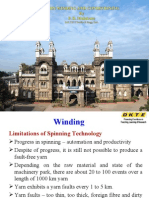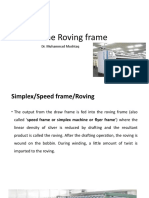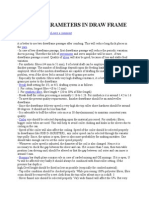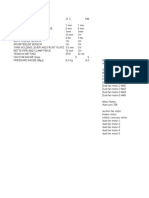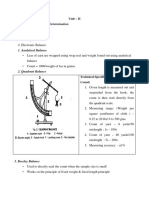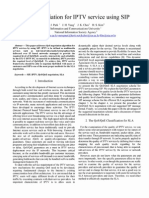0 ratings0% found this document useful (0 votes)
1K viewsYarn Eveness Tester
Yarn Eveness Tester
Uploaded by
vasineyThe document discusses yarn evenness and hairiness. It defines random and periodic variations in yarn and describes methods of measuring evenness including visual examination, cutting and weighing, and electronic testers. It provides details on the Uster evenness tester, describing its principle, components, and how it is used to measure unevenness, coefficient of variation of mass, imperfections, and hairiness. The Uster tester allows for analysis of periodic variations through spectrograms.
Copyright:
© All Rights Reserved
Available Formats
Download as PPTX, PDF, TXT or read online from Scribd
Yarn Eveness Tester
Yarn Eveness Tester
Uploaded by
vasiney0 ratings0% found this document useful (0 votes)
1K views32 pagesThe document discusses yarn evenness and hairiness. It defines random and periodic variations in yarn and describes methods of measuring evenness including visual examination, cutting and weighing, and electronic testers. It provides details on the Uster evenness tester, describing its principle, components, and how it is used to measure unevenness, coefficient of variation of mass, imperfections, and hairiness. The Uster tester allows for analysis of periodic variations through spectrograms.
Original Description:
USTER EVENNESS TESTER
Original Title
YARN EVENESS TESTER
Copyright
© © All Rights Reserved
Available Formats
PPTX, PDF, TXT or read online from Scribd
Share this document
Did you find this document useful?
Is this content inappropriate?
The document discusses yarn evenness and hairiness. It defines random and periodic variations in yarn and describes methods of measuring evenness including visual examination, cutting and weighing, and electronic testers. It provides details on the Uster evenness tester, describing its principle, components, and how it is used to measure unevenness, coefficient of variation of mass, imperfections, and hairiness. The Uster tester allows for analysis of periodic variations through spectrograms.
Copyright:
© All Rights Reserved
Available Formats
Download as PPTX, PDF, TXT or read online from Scribd
Download as pptx, pdf, or txt
0 ratings0% found this document useful (0 votes)
1K views32 pagesYarn Eveness Tester
Yarn Eveness Tester
Uploaded by
vasineyThe document discusses yarn evenness and hairiness. It defines random and periodic variations in yarn and describes methods of measuring evenness including visual examination, cutting and weighing, and electronic testers. It provides details on the Uster evenness tester, describing its principle, components, and how it is used to measure unevenness, coefficient of variation of mass, imperfections, and hairiness. The Uster tester allows for analysis of periodic variations through spectrograms.
Copyright:
© All Rights Reserved
Available Formats
Download as PPTX, PDF, TXT or read online from Scribd
Download as pptx, pdf, or txt
You are on page 1of 32
Yarn Evenness and Hairiness
Yarn Evenness and Hairiness:
• Yarn appearance board winder.
• Classification of variations in yarn, methods of
measuring yarn evenness and hairiness, Uster
evenness tester.
Learning outcomes:
1. Demonstrate the working principle of
Evenness and hairiness tester
2. Describe the types of yarn faults and variation.
YARN EVENNESS
• The different terms used, such as evenness or
unevenness and regularity or irregularity.
• For textile products such as laps, slivers,
rovings, and yarns, which are the products of
various spinning machines.
• The level of uniformity is expressed in terms of
evenness or regularity or in terms of
unevenness or irregularity.
Causes of irregularity
• Properties of raw material
• Fibre arrangement in the yarn
• Fibre behaviour
• Inherent shortcoming of machinery
• Mechanically defective machinery
• External factors such as working condition and
inefficient operation
Classification of variation
There are two types of variation:
– Random variation and
– Periodic variation.
Random variation
• It is the variation which occurs randomly in the
textile material and can occur in any order.
• A yarn is cut into short, equal lengths, say, 1
inch, then the weight of each consecutive
lengths can be measured a as shown in Figure
Periodic variations
• All traces of irregularity do not show random
distribution of deviations from the mean. Suppose
traces show definite sequences of thick and thin
places in the strands.
• These forms of irregularity are called as periodic
variations.
• Periodic variations are the variations with definite
sequences of thick and thin places in the strands.
• There are two terms used to describe a periodic
variation - wave length and amplitude
• Wave length is the
distance between
one peak of the
wave and the next
on the same side of
the mean line.
• Amplitude is a
measure of the size
of the swing from
the mean level.
• Usually, this is
expressed as a
percentage of the
mean.
Variations based on fibre length
• Using the fibre length as a length unit
• The periodic variations in the fibrous strand are
classified according to their wavelength with
respect to the fibre length used for forming
that particular strand.
This variation classified in to
• Short term variations
• Medium term variations
• Long-term variations
Short-term variation:
• Wave length is 1 to 10 times the length of the
fibre.
Medium-term variation:
• Wave length is 10 to 100 times the length of the
fibre.
Long-term variation:
• Wave length is 100 to 1000 times the length of
the fibre.
• This classification is used for investigating
and determining the causes of faults.
• The amplitude of short-term variation is
generally greater than that of the long-term
variation because it occurs at the last machine
and has not been reduced by doubling.
Methods of measuring evenness
Visual examination methods
Black boards, drums, photographic devices,
projectors and lap meter
Cutting and weighing methods
• Lap scale, lap meter, sliver, roving and yarn
wrapping
Electronic capacitance testers
• Fielden-Walker evenness tester and Uster
evenness tester
Variation in thickness under compression
• WIRA roving levelness tester and LINRA
roller yarn diameter tester
Photoelectric testers
• WIRA photoelectric testers and LINRA tester
Miscellaneous methods
• Airflow, mercury displacement and so on
Yarn Appearance Board Winder
• Yarn to be examined is wrapped onto a matt black
surface in equally spaced turns.
• The black boards are then examined under good
lighting conditions using uniform non-directional light.
• ASTM has a series of Cotton Yarn Appearance
Standards which are photographs of different counts
with the appearances classified into four grades.
• The test yarn is then wound on a blackboard (measuring
9.5 x 5.5 inches in surface area) with correct spacing
and compared directly with its corresponding standard.
Types
• Both hand-driven and
• Motorized wrapping machines
ASTM Standards
• ASTM standard test method classifies the yarn appearance
into five grades.
• The board is compared with standard photographs and
then graded.
• Grade A: No large neps, very few small neps, must have
very good uniformity, less fuzziness.
• Grade B: No larger neps, few small neps, less than three
small pieces of foreign matters per board, slightly more
irregular and fuzzy than A.
• Grade C: Some larger neps and more smaller neps,
fuzziness, foreign matters more than B, more rough
appearance than B.
• Grade D: Some slubs (with diameter 3 times
the diameter of yarn). More neps, larger neps,
fuzziness, thick and thin places, foreign
matters than in Grade C yarn. Overall
appearance is rougher than C.
• Grade E: Below grade D; more defects and
overall rougher appearance than grade D yarn.
Yarn appearance indices
Grade Designation Index
A EXCELLENT 130
B+ VERY GOOD 120
B GOOD 110
C+ AVERAGE 100
C FAIR 90
D POOR 80
D + VERY POOR 70
BG BELOW GRADE 60
USTER evenness tester
• USTER evenness tester is used to calculate
• The unevenness (U%),
• Coefficient of Variation of Mass (Cvm%),
• Yarn Hairiness,
• Imperfection index (IPI) and
• Thick place,
• Thin place,
• Neps
Principle of USTER evenness tester
• Uster evenness tester is “Electronics capacitance
tester principle”.
• The quality parameter is determined by a capacitive
sensor.
• The yarn, roving or sliver is passed through the
electric field of a measuring capacitor.
• Mass variation of material causes disturbance in the
electric field, which is then converted into electric
signal.
• This is proportional to the mass variation of material.
• The unevenness is recorded as a diagram.
The instrument consists of three main units
• The tester
• Signal processor
• printer
Measuring capacitors:
• Material to be tested any slot can be selected out of the
‘eight measuring capacitors’
Creel & Guide:
• These are to hold the package of material and to guide them
into the correct position into the slot
Traverse Rollers:
• The material speed passing over the range from 2 to 400
MPM
Measuring Device:
• Material to be tested any slot can be selected out
of the ‘eight measuring capacitors’
Type of material Slot No
- Sliver 1,2,3
- Roving 4,5
- Yarn: 2 – 17s 6
18 – 60s 7
above 60s 8
Material Speed:
• Yarn speed of the testing 200 mpm
• High speed instrument of the testing 400 mpm
Imperfection Indicator:
• Uster imperfection indicator measure the faults neps, thick
and thin places.
NEPS:
• It is a fault length 1 mm, having a cross-section 200% of
average value.
THICK PLACE:
• It is a fault of length approximately the fibre staple length,
having a cross-section of 50% increase over the average
value.
Thin Place:
• It is a fault of length approximately the fibre
staple length, having a cross-section
approximately 50% less than the average value
Spectrograph:
• To analysis of ‘periodic variation’
Periodic variation:
• Due to imperfect fibre control – leading to
drafting weaves
• Mechanical defects in the machinery
Imperfections
• In the Uster Tester, the following sensitivity
levels are available (Table).
Thin places Thick places Neps
- 60 % + 100 (1) + 400 % (1)
- 50 % + 70 (2) + 280 % (2)
- 40% + 50 (3) + 200 % (3)
- 30% + 35 (4) + 140 % (4)
Spectrogram :
Advantages of USTER evenness tester
• The CV percentage measured by USTER gives
a measure of the variation of weight per unit
length.
• This instrument measures the irregularity of
material at high speed (2- 100 ft/min).
• It can show the percentage of both MD and CV
of material.
• The recorder of pen can work at a high speed of
100 yards/min.
Uses of USTER evenness tester
• Evenness measurement of yarn, roving and sliver
• Measurement of imperfection (thick, thin place,
neps)
• Mass analysis
• Spectrogram analysis/frequency analysis
• Yarn hairiness measurement
• Fabric simulation, that is, before making fabric; this
way knowledge is gained about the yarn quality
that ultimately determines the quality of fabric
• Variation of trend analysis
You might also like
- Yarn Tension and Balloon Geometry in Ring SpinningDocument18 pagesYarn Tension and Balloon Geometry in Ring Spinningapi-1996555383% (6)
- Rotor PrincipleDocument12 pagesRotor PrincipleAnkit Balotia67% (3)
- Presentation On: Different Parts of Ring FrameDocument15 pagesPresentation On: Different Parts of Ring FrameTowfic Aziz Kanon100% (3)
- Yarn Faults: Types Causes RemediesDocument20 pagesYarn Faults: Types Causes Remediesஹரி கிருஷ்ணன் வாசு71% (7)
- Yarn Numbering System - CountDocument45 pagesYarn Numbering System - CountvasineyNo ratings yet
- Textile Chemical Processing 11Document64 pagesTextile Chemical Processing 11vasiney50% (2)
- Synchronous MachinesDocument24 pagesSynchronous MachinesJones Bk EssumanNo ratings yet
- Yarn WindingDocument22 pagesYarn WindingPRAKASH B. MALAKANE0% (1)
- Textile in DepthDocument59 pagesTextile in DepthBoopathi Sadasivam50% (2)
- Investigation Yarn Count Variation of Ring FrameDocument63 pagesInvestigation Yarn Count Variation of Ring FrameYeasin Arafat100% (1)
- Process Control SpinningDocument25 pagesProcess Control SpinningNessre Zeine100% (2)
- ClassimatDocument11 pagesClassimatRonak JoshiNo ratings yet
- USTER HVI Spectrum Measuring PrinciplesDocument45 pagesUSTER HVI Spectrum Measuring PrinciplesRAMARAMRAM100% (2)
- USTER AFIS PRO Measurement Principle Test ResultsDocument109 pagesUSTER AFIS PRO Measurement Principle Test ResultsMd. Humayun KabirNo ratings yet
- Yarn Clearing SystemsDocument11 pagesYarn Clearing SystemsLohit MohapatraNo ratings yet
- The Roving FrameDocument14 pagesThe Roving FrameMaham ButtNo ratings yet
- Process Parameters in DrawDocument5 pagesProcess Parameters in DrawTemesgen RegassaNo ratings yet
- Twist MultiplierDocument1 pageTwist MultiplierAniket Mahajan100% (5)
- Project Report - Breakage in RingframeDocument16 pagesProject Report - Breakage in RingframeSushmita KushwahaNo ratings yet
- Ring FrameDocument9 pagesRing FrameArabinda ChandNo ratings yet
- Spinning Geometry of Ring Spinning MachineDocument19 pagesSpinning Geometry of Ring Spinning MachineSahlu Klemewerk Daget0% (1)
- LRT HandbookDocument41 pagesLRT HandbookAshok Kumar60% (5)
- Fiber RuptureDocument16 pagesFiber RuptureNessre Zeine100% (1)
- Impact of Cotton Parameters On Yarn QualityDocument4 pagesImpact of Cotton Parameters On Yarn Qualityغلام جیلانی100% (6)
- Process Parameters in Draw FrameDocument3 pagesProcess Parameters in Draw FrameYogeshkumar j joshiNo ratings yet
- Quailty Control in SpinningDocument30 pagesQuailty Control in SpinningRounoque ShishirNo ratings yet
- Auto Cone ComparisonDocument8 pagesAuto Cone ComparisonMuhammad Talha100% (1)
- Draw Frame Hooks ControlDocument17 pagesDraw Frame Hooks ControlNeelakandan DNo ratings yet
- 2.1 Quailty Control in SpinningDocument31 pages2.1 Quailty Control in SpinningRounoque ShishirNo ratings yet
- 1.bale Management SystemDocument8 pages1.bale Management SystemMd Nurunnabi50% (2)
- Spinpact Fine Tuning HandbookDocument10 pagesSpinpact Fine Tuning Handbookselvakumar100% (1)
- Spinning Prepretory - II 18-19Document51 pagesSpinning Prepretory - II 18-19Sushil Mali100% (4)
- Spinning Maths-4 PDFDocument9 pagesSpinning Maths-4 PDFSantosh0% (1)
- Ring Spinning PDFDocument45 pagesRing Spinning PDFNazmul-HassanNo ratings yet
- Compact SpinningDocument16 pagesCompact SpinningShankar V Iyer100% (1)
- Control Startup BreakageDocument4 pagesControl Startup BreakageAnish ak100% (5)
- Auto ConerDocument47 pagesAuto Conerkaniappan sakthivelNo ratings yet
- Conversion of Weight Units: Useful Informations To The SpinnersDocument5 pagesConversion of Weight Units: Useful Informations To The SpinnersGautam SootgirniNo ratings yet
- Uster ClassimatDocument10 pagesUster ClassimatAbu Bakkar71% (7)
- SECTIONAL WarpingDocument23 pagesSECTIONAL Warpinggovardhan6rao100% (1)
- Automation in Ring Spinning Machines-KTTMDocument24 pagesAutomation in Ring Spinning Machines-KTTMkathirvelus940850% (2)
- CV CalculationDocument7 pagesCV CalculationNirbhay Sharma71% (7)
- Yarn FaultsDocument69 pagesYarn Faultssitu_tex8594100% (3)
- Chapter - Three: Yarn Count, Yarn Twist and Tensile TestingDocument57 pagesChapter - Three: Yarn Count, Yarn Twist and Tensile TestingGadisa AbrahimNo ratings yet
- This Study Resource Was: Speed FrameDocument9 pagesThis Study Resource Was: Speed FrameRatul HasanNo ratings yet
- Ring FrameDocument5 pagesRing FrameMoinamotiNo ratings yet
- Draw FrameDocument50 pagesDraw FrameDev Narayan KushwahaNo ratings yet
- Investigative Study of Periodic Yarn Faults and Its Removal by Using Gearing AnalysisDocument59 pagesInvestigative Study of Periodic Yarn Faults and Its Removal by Using Gearing AnalysisJuan Cubas100% (1)
- Process Parameters in SimplexDocument3 pagesProcess Parameters in SimplexTanvir Alam100% (6)
- Classification of Yarn Faults and Possible SourceDocument4 pagesClassification of Yarn Faults and Possible SourceNagarajan Sivathanu Pillai50% (2)
- LRTDocument5 pagesLRTAnish akNo ratings yet
- Winding 1Document16 pagesWinding 1Siddhesh Pradhan67% (3)
- Controlling and Check Points in Spinning ProcessDocument10 pagesControlling and Check Points in Spinning ProcessBithy Paul100% (1)
- Auto Coner Machine OperatorDocument15 pagesAuto Coner Machine Operatorzeeshan_22050% (2)
- Process Control in SpinningDocument31 pagesProcess Control in Spinningapi-2649455553% (15)
- Unit 3 Textile Testing-IIDocument67 pagesUnit 3 Textile Testing-IIka546878No ratings yet
- Evenness: Methods of Measuring Yarn EvennessDocument14 pagesEvenness: Methods of Measuring Yarn EvennessJuan CubasNo ratings yet
- TESTINGDocument20 pagesTESTINGRaghvendra SinghNo ratings yet
- FS Assignment 3Document45 pagesFS Assignment 3nikitaNo ratings yet
- Unit - IiDocument27 pagesUnit - IiJoseph KuruvilaNo ratings yet
- Yarn Unevenness and Its Impact On QualityDocument24 pagesYarn Unevenness and Its Impact On QualityShan ImtiazNo ratings yet
- Ram 1234Document25 pagesRam 1234Nicholas GonzalezNo ratings yet
- JacquardDocument54 pagesJacquardvasineyNo ratings yet
- Warp KnittingDocument22 pagesWarp KnittingvasineyNo ratings yet
- Unit III DobbyDocument32 pagesUnit III DobbyvasineyNo ratings yet
- Shuttleless LoomDocument64 pagesShuttleless LoomvasineyNo ratings yet
- Beat-Up MechanismDocument39 pagesBeat-Up MechanismvasineyNo ratings yet
- Textile and Apparel Quality EvaluationDocument65 pagesTextile and Apparel Quality EvaluationvasineyNo ratings yet
- Non WovenDocument95 pagesNon WovenvasineyNo ratings yet
- FABRIC MANUFACTURE Two Marks Question With AnswerDocument12 pagesFABRIC MANUFACTURE Two Marks Question With AnswervasineyNo ratings yet
- Flat Bed KnitingDocument21 pagesFlat Bed Knitingvasiney100% (1)
- Digital Control Systems (DCS) : Lecture-1-2 Lead CompensationDocument61 pagesDigital Control Systems (DCS) : Lecture-1-2 Lead CompensationMeer Zafarullah NoohaniNo ratings yet
- Computer Graphics Hardware: 1 The CRT DisplayDocument8 pagesComputer Graphics Hardware: 1 The CRT DisplaySourav SinghNo ratings yet
- CMS Client Manual (V5.90)Document106 pagesCMS Client Manual (V5.90)Maston DJauhari0% (1)
- Item 20 PG 244 1756-td002 - En-E-244Document1 pageItem 20 PG 244 1756-td002 - En-E-244Minerva Figueroa VivasNo ratings yet
- Cisco ASADocument3 pagesCisco ASATibi GoanţăNo ratings yet
- TV Freeview Akura AMTDT-2010 ManualDocument23 pagesTV Freeview Akura AMTDT-2010 ManualEnrico959No ratings yet
- TL431 TL432Document79 pagesTL431 TL432JADERSONNo ratings yet
- Further Details On Lead Free Reflow Soldering of LEDsDocument16 pagesFurther Details On Lead Free Reflow Soldering of LEDshuynh thi y viNo ratings yet
- Chapter 6Document10 pagesChapter 6MonikaNo ratings yet
- Lab No 11 Dr. Tariq Bashir Osama Sattar FA19-BEE-172 - 4D Electronics 2Document5 pagesLab No 11 Dr. Tariq Bashir Osama Sattar FA19-BEE-172 - 4D Electronics 2Souban JavedNo ratings yet
- Tle Electronics 9 - SummativeDocument2 pagesTle Electronics 9 - SummativeChristine Joy E. Sanchez-CasteloNo ratings yet
- Ace G225LHDocument17 pagesAce G225LHAntonioMurteiraNo ratings yet
- Easy Soft ManualDocument117 pagesEasy Soft ManualroscovanulNo ratings yet
- FieldFox Handheld Analyzers 4 - 6.5 - 9 - 14 - 18 - 26.5 - 32 - 44 - 50 - 54 GHZ (B and C Models)Document28 pagesFieldFox Handheld Analyzers 4 - 6.5 - 9 - 14 - 18 - 26.5 - 32 - 44 - 50 - 54 GHZ (B and C Models)Ahsan RafiqNo ratings yet
- Notes On Camshaft Selection - Gary LewisDocument4 pagesNotes On Camshaft Selection - Gary Lewisgaragepunkfan100% (3)
- Ah3000 Chino Recorder ManualDocument119 pagesAh3000 Chino Recorder ManualCarlos E. Delius SciaroniNo ratings yet
- Fl2 Handbook 2012Document229 pagesFl2 Handbook 2012agushayaNo ratings yet
- 360v-200ah GTPDocument1 page360v-200ah GTPShanmuganathan ShanNo ratings yet
- ADAM Guidelines For Entrance Test - Syllabus Evaluation V01 July 2018Document16 pagesADAM Guidelines For Entrance Test - Syllabus Evaluation V01 July 2018Arnav NaulaNo ratings yet
- Lmx2324A: Lmx2324A Pllatinum 2.2 GHZ Frequency Synthesizer For RF Personal Communications (Sl163188)Document14 pagesLmx2324A: Lmx2324A Pllatinum 2.2 GHZ Frequency Synthesizer For RF Personal Communications (Sl163188)arunprabhumailsNo ratings yet
- Canbus Wiring For DSE ControllersDocument90 pagesCanbus Wiring For DSE ControllersBejoy ThomasNo ratings yet
- Bluetooth Based 360 Degree Rotating MachineDocument69 pagesBluetooth Based 360 Degree Rotating Machinesakethdandu628No ratings yet
- Anti HeelingDocument5 pagesAnti HeelingplatasturNo ratings yet
- Power Your Signal: Antenna SpecificationsDocument3 pagesPower Your Signal: Antenna SpecificationsMariNo ratings yet
- QoS in IPTVDocument4 pagesQoS in IPTVGerlan CidadeNo ratings yet
- Hitachi CMP307XE Plasma TV Service ManualDocument15 pagesHitachi CMP307XE Plasma TV Service ManualGreta HattNo ratings yet
- Consonance: Lithium Ion Battery Charger For Solar-Powered SystemsDocument11 pagesConsonance: Lithium Ion Battery Charger For Solar-Powered SystemsGabriel Andriano BNo ratings yet
- Product Information Model 9602-IDocument1 pageProduct Information Model 9602-IEric BolerNo ratings yet
- EEC 214 Lecture 1Document34 pagesEEC 214 Lecture 1yhya TarekNo ratings yet







